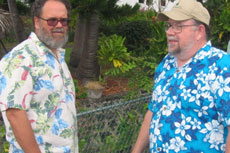Human Flower Project
Saturday, April 12, 2008
Twickenham, or London ‘Recovered’
Unfolding a map of London, John Levett sets out for an old bastion of privilege; crossing a bridge, here are magnolias, a common, a view. Thank you, John.
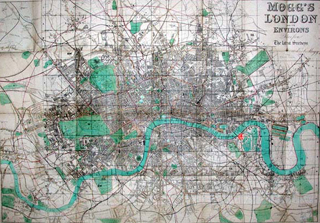
Mogg’s postal district and cabfare map of London
Image: Emonson Family History
By .(JavaScript must be enabled to view this email address)
I was almost born in London but not quite. My mother’s labour came too early for that so I was diverted elsewhere but we arrived there some six years later. I grew up in the fiercely middle class suburb of Bromley. My mother ran a small grocer’s shop and was visited at yearly intervals by the freeholder to see what needed doing to the property then did nothing. For the post-war British middle class, time was going to have to stand still at some point and it was in the early 1950s that time came to an end for those of a certain age in Bromley for whom the Coronation year of 1953 was possibly ‘the last best time.’
I came to this thought from having discovered a cousin. I write ‘discovered’ but should, maybe, describe her as ‘recovered.’ I lost contact with what remained of my extended family in the mid-‘90s for reasons it would take a book to explain and another to describe what led me to seek them out; my cousin and her husband were the only ones I once knew who were still living. They were of a generation born at the start of the ‘Long Weekend’ of the 1930s who came to maturity in the early 50s and would now be enjoying the fruits, benefits and cookies of non-compulsory activity — life with the kids, safaris (didn’t those go out with Grace Kelly, Clark Gable and Mogambo?), walks across Indian beaches, watching the sun go down on Ayers Rock. They won’t be doing any of that; my cousin has a degenerative neurological condition and the only treatment is to make the decline easier than it might otherwise be. But describing her as ‘recovered’ is still appropriate.
I’m not getting here into a palaver about the resilience of the human spirit or the beauty of the inner self; knowing you’re degenerating and losing contact with all the facility you once had isn’t uplifting—not for you nor anyone around you. This was the time you looked forward to; promises you made to yourself and each other; something deserving after the toil and toeing the line. Not to be. I started visiting my cousin regularly, catching up on both our lives and the trip-ups in both. Our pasts are always there but this past also had something concrete.
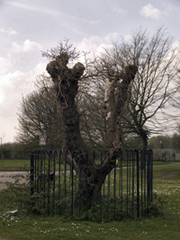 Fenced tree, Ham
Fenced tree, Ham
Photo: John Levett
As a result of the various deaths in the family my cousin had become the ‘keeper of the family archive’—the snaps of a century. There’s too much to tell here so I’ll cut to the chase. The family had become Londoners in the second half of the nineteenth century, coming down the fifty or so miles from Suffolk and setting up their stall in south London near Greenwich before spreading throughout Kent. Looking through the family albums and reflecting on the scattering of the seeding family a quaint thought came to me—how little of London I’d known outside its south-east boundary and its arterial roads into its centre. I noticed how I’d always travelled into London by the same routes and out the other side by a similarly familiar trail. Throughout my growing-up years I’d clung to the safe—same buses, same trains; same clubs, same pubs; same bookshops, same record stores—never touching another point on the London boundary.
Last Thursday I took out a map of London and found out where I’d never been. There was a lot of it. I looked west along the course of the Thames—Barnes and Chiswick; Richmond and Twickenham; Brentford and Hounslow; then north through Harrow, Ruislip, Northwood; south even to Wimbledon and Kingston. I’d never had any cause it seems. I could attach associations—Battle of Britain fighter squadrons, sport, horses, births and deaths —but no compulsive need to trip off there. So I chose. Twickenham would do.
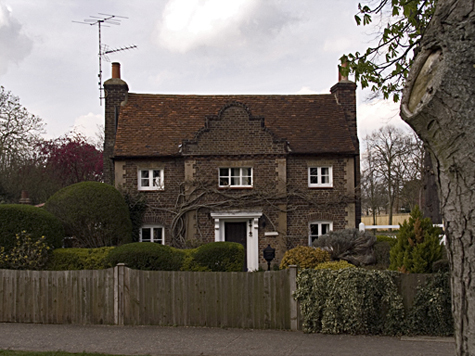
Dutch House, Twinckenham
Photo: John Levett
The moment I chose I knew why I’d never been there. Twickenham is home to the English Rugby Union and throughout my growing years rugby was associated with the class enemy, chinless wonders, hooray harrys, unearned privilege, family advantage and not the sport of the sons and daughters of toil and soil. It’s changed; they’re now as unremittingly bourgeois as the rest of western Europe. I trooped down from Cambridge and caught the 11.50 out of Waterloo. Another first; I’d never taken a mainline train from there before. (Footnote: John Schlesinger made a film of Waterloo station early in his career, Terminus 1960.) I passed through Clapham Junction and made a note that I’d never been there either. Thence to the suburbs.
 St. Alban’s Church, Twickenham
St. Alban’s Church, Twickenham
Photo: John Levett
Twickenham promised nothing. Like every suburb, town, city in this increasingly dis-United Kingdom it’s got the full complement of corporations in the High street (with the singular exception, as far as I could see, of Woolworth. Whatever happened to them? I used to spend an afternoon in Woolworth as a kid just looking at stuff). I took off for the nearest available Thames bridge some two miles away.
As I walked I began to warm to the place. Much of the housing development was post 1880s and was in great debt to the early patriarchs of Modernism—Voysey, Webb, Townsend. It tails off into early 1900s pattern-book eclecticism but there are enough features on enough houses to stop for. As I closed on Teddington lock I stopped at St. Alban’s church. It was begun during the high point of mid-Victorian self-confidence and opened to the prayerful in 1899, curtailed its activity when the subscriptions dropped off and fell into disrepair. Like many similar parish enterprises it now serves as an arts centre. I crossed the Thames into Ham.

Ham Common
Photo: John Levett
Now I knew that ‘Ham’ had something to do with a bend in the river and that didn’t take much working out but beside that I knew nothing. So I asked. Ham is on the southern boundary of Richmond Park which is deemed to be a Royal park which means that some Royal stole the land from the peasantry who held it in common. That Royal was Charles I who clearly paid heavily for the theft. Needless to say the payment didn’t involve handing back the land. Some common land was left; cunningly named Ham Common and a fine spot it is. Having walked around the backside of Ham and getting the impression it was all 1920s social housing with the inevitable mock Tudor affairs, Ham Common was a joy. I sat down and got all this info chatting with Alfred who had come here after demob from the last war. (No doubt there will shortly be a generation, if it hasn’t already arrived, for whom the term ‘the last war’ will mean no more than ‘the last war before the present one’ and each indistinguishable from any other.)
Alfred married Bettie and moved into Bettie’s family home because it was just off the Common and Bettie wasn’t moving because they’d never get anything as lovely. Bettie’s parents died within the decade and they had the place to themselves and their own family. Bettie knew a thing or two.
From Alfred I got the history—the Common, Richmond Park, Ham House, the ferry across the Thames, his family, other families, that house over there, the murder there, the plane crash. It was the warmest day of the year so far so sitting around was fine.
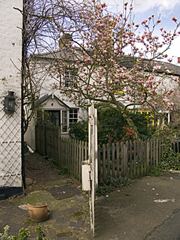 Magnolia, blooming in Ham
Magnolia, blooming in Ham
Photo: John Levett
When Alf took off so did I. Walking the back streets. You could make a forest from the number of magnolias in bloom. I often think that should I have space one day for one plant only then the magnolia it should be. I’ve never cared about the flowering season of anything I’ve ever planted (my rose garden has largely been and gone by high summer) and the lift to the spirit that magnolias bring is special.
I walked past Ham House towards the Thames and chose to walk the bank to Richmond. Not that there was much choice. My London means a bridge available whenever needed; not a walk of a mile or paying the ferryman.
One feature of the London A-Z is that it has no contours so I was surprised by Richmond Hill rising some couple of hundred metres from the Thames and a view straight through to the southern Weald. It’s not Table Mountain nor the view from Machu Picchu but I’d never seen it before; never seen this view of the Thames other than the one passing Charing Cross; never knew London was this tall; never felt the surprise of a city new to me. I may seem small beer but I thought once I knew it all. Then a few more pennies dropped. The habits of my early years I’d taken with me through decades. Always took the same route to school; always got off at the same bus stop, never one stage before or one after; strolled from this place to that, looked in the same store windows; it seemed to me that I still do. I realized it was the same with my cycle rides; anti-clockwise out of Cambridge whichever point of the compass I was aiming for hence I always get the same scenery at right and left.

View of the Thames from Richmond Hill
Photo: John Levett
It may seem strange that something that is someone else’s daily grind gives a heart a leap. But then it should; there should be wonder in small things; there should be daily discovery; there should be looking up; there should be a daily new horizon. Sitting on the top of Richmond Hill I hoped that the Richmondians took joy too as I do walking along the Backs. It’s often forgotten that people pay good money to visit what we see as our own back garden. Two days ago I found a small booklet on Cambridge architecture contemporary in 1960 on a market stall. I was struck by how much I’d never noticed; bold-for-its-moment design, bold-for-any-age innovation that had now been blended by its generic successors. Yesterday I started a walk wide-eyed and camera-laden looking for this stuff. The stuff I was looking for is not King’s College Chapel nor Wren’s Trinity Library which means it’s no doubt continually under threat; 1960s concrete is not beloved, hospital architecture disappears with changing demands, pupils outgrow schools, shopping arcades fall with the styles they sell. But there is a remarkable volume of seen-as-disposable building that I’d never noticed, never seen as more than purely functional (which maybe accounts for its success and continuation). It seems that in twenty-first century fashion I’d easily cast off easily-acquired, soon-too-familiar views. I’ve begun to rethink, review two favourite cities. Fun for all the family.
